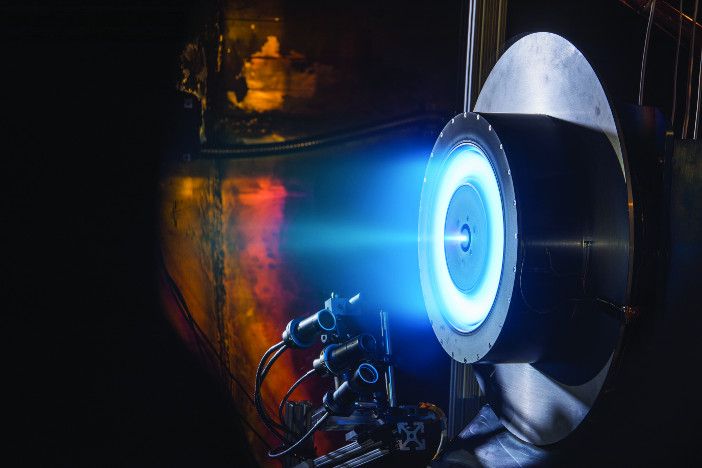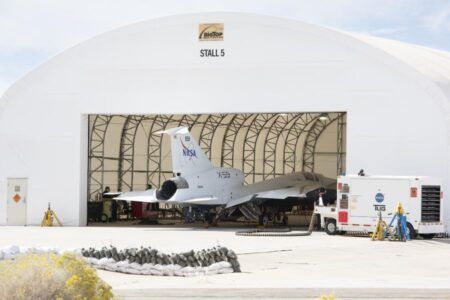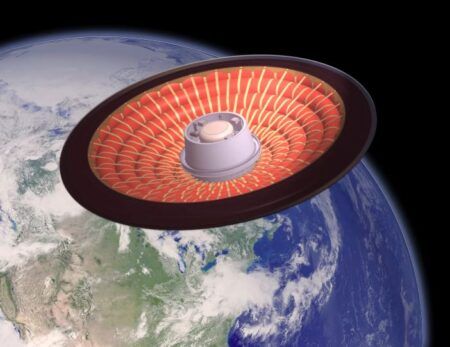Somewhere in Princeton, New Jersey, a small team of physicists is hard at work making plasma in a lab. Plasma, a superheated gas that is ionized or electrically conductive, is already around us in many forms. Lightning and neon signs are examples of partially ionized plasma.
The center of the sun is fully ionized plasma. In the past two decades, plasma has entered the field of aerospace engineering through its use in ion thrusters. These small, plasma-powered engines are used on many modern satellites.
Plasma is made by subjecting a gas to a strong electromagnetic field. This causes electrons to begin breaking free of atoms, leading to the creation of positively charged particles known as ions. In an ion thruster, electric fields are used to push ions contained in a gas propellant out of the engine’s nozzle at high speed to create thrust.
“It’s the same force that causes the hairs to stand up on your head if you were in an environment with a lot of static,” says Dr Charles Swanson, a staff physicist at Princeton Satellite Systems, the NASA-funded startup involved in the Princeton lab tests.
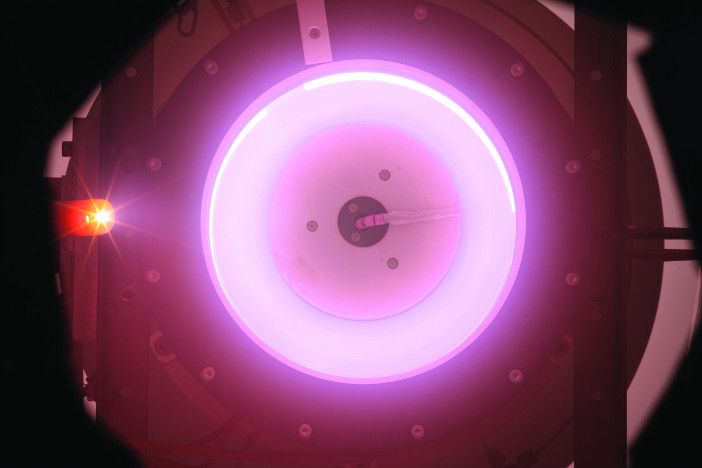
One of the company’s research projects is developing a Direct Fusion Drive, a 1-10MW rocket engine that could one day be used to propel a variety of space missions.
Plasma is a dangerous material to work with – not least because of the extremely high voltages necessary to create it. As a result, safety is paramount in the lab environment.
“Everything high voltage has to have ground-fault interrupters,” Swanson says. “We wear safety goggles and big insulating gloves.”
He and his team wear rubber-soled boots and only work with their right hands, keeping the left in their pocket at all times. This prevents the current from closing through the chest, keeping the heart safe in the event of an electric shock.
Swanson also wears a radiation dosimeter because at extreme heats plasma can actually generate x-rays. And the plasma does indeed get very hot.
“Our machine heats electrons up to hundreds of electron volts, which is the same energy they would have halfway to the core of the sun,” he says.
Nuclear fusion
To most, this level of heat is unfathomable. But for Swanson and his team it’s only the beginning.
They need to generate temperatures many orders of magnitude higher. Because Princeton Satellite Systems is not interested in making a conventional ion thruster. Its goal is to create a thruster powered by nuclear fusion.
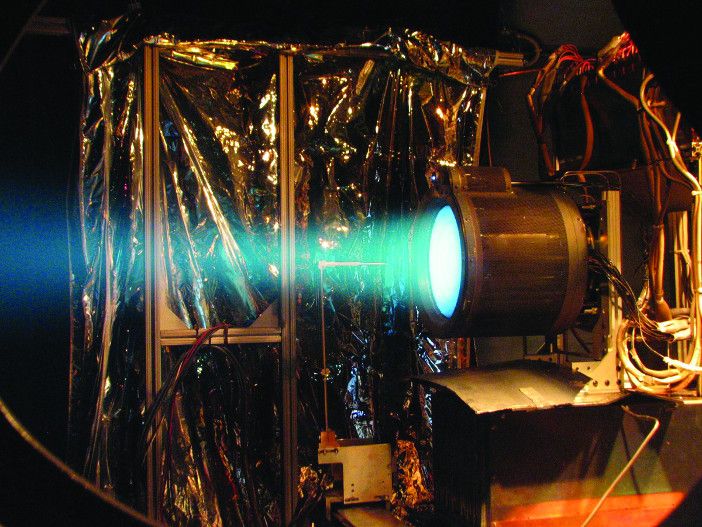
To do this, the team must heat the ions in a plasma to temperatures so extreme that they actually fuse together. They aim to do this through a gradual approach, says Swanson. “With this machine, after we perform some magnetic field upgrades, we expect to prove our mechanism for heating ions.
“From there, it will be a matter of scaling up. There’ll be an intermediate machine, where we go from heating ions up to 1keV. Then with the next machine we expect to reach 5keV. The machine after that would be thermonuclear – dozens of kilo-electronvolts.”
Creating this kind of heat is very difficult, but the pay-off in terms of energy output is huge. Fusion, after all, is what powers stars and its potential as an energy source of the future has led to a number of projects down the years. The most conspicuous of these is the multinational International Thermonuclear Experimental Reactor (ITER) experiment, a massive donut-shaped fusion reactor currently under construction near Saint Paul-lez-Durance in southern France.
The reactor Swanson is developing for use in ion thrusters is much smaller – just 1.5m (5ft) across by 4-8m (13-26ft) long.
But although building a small-scale fusion reactor to fit on spacecraft sounds daunting, it is not the hardest part of the work.
“Generating fusion power isn’t the puzzle,” Swanson says. “Significant amounts of fusion power were generated in the 1990s. The puzzle is converting the energy output from the reactor into thrust.”
Princeton Satellite Systems plans to solve the conundrum with an engine design composed of two layers of plasma – a super-heated core and a cooler outer layer. As hot ions from the core heat up the cooler plasma, an energy transfer will cause this outer layer to expand into a magnetic nozzle at the rear, resulting in thrust.
Swanson says, “It turns a hot, slow-moving plasma into a cold, fast-moving plasma. It’s like the constriction in a conventional rocket nozzle – except it’s all mediated by a magnetic field.”
Probing plasma
Princeton Satellite Systems isn’t the only startup developing fusion-powered spacecraft. In a warehouse in Oxfordshire, England, engineers from Applied Fusion Systems are testing their own small nuclear fusion reactor to examine its properties as a thruster.
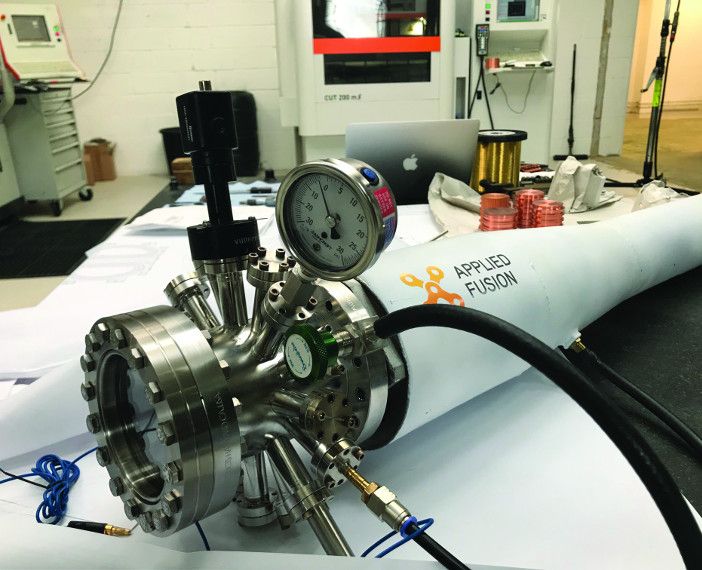
“If you can create the conditions for fusion, then the same device that is used to generate power would be capable of very fast exhaust speeds if reconfigured as a rocket,” says Richard Dinan, CEO of Applied Fusion Systems. “I think we’ll be deploying these devices in space before we’re powering homes with them.”
To fully understand how a fusion thruster will perform in space, Dinan’s team must first recreate the conditions of space on Earth. They accomplish this using a vacuum vessel. These are regularly used to test ion thrusters and their close variant, Hall-effect thrusters.
Usually the thruster is mounted on cables hanging from the ceiling of the vacuum chamber – a configuration known as a thrust stand. The engine is powered up and the thrust generated causes the thruster to tilt.
Measuring the angle of tilt enables engineers to calculate the thrust being generated. For more in-depth analysis of an engine’s performance, more complex measuring equipment is required, says Dr Jason Cassibry, a professor in aerospace engineering at the University of Alabama.
“With fusion, depending on the type of fuel, you’re most likely going to be looking at neutrons as the diagnostic to tell you how much energy is released,” he says.
To measure neutrons, scientists use a scintillation probe, a device that works by generating photons in response to radiation and converts the light to an electrical signal using a photodetector and charge-coupled device. But in the case of superheated materials like plasma, use of the probes can become problematic.
Cassibry says, “Any kind of probe that you stick in hot plasma is going to be so much colder than the plasma that it will affect the temperature of the material and you’ll get a false reading. So you try to monitor it in a way that doesn’t directly interfere with the plasma.”
Plasma is so hot that its electromagnetic spectrum is mostly in the x-ray region. Because of this, says Cassibry, x-ray diagnostics can be used by test engineers to look at the plasma and infer data about its structure, emissions and temperature without having to touch it.
Testing plasma engines throws up the added puzzle of how to manipulate and move things inside vacuum vessels. There are various solutions to this problem, says Swanson. He points to a robotic arm used in the Joint European Torus (JET), which is the world’s largest operational plasma physics experiment, located in the Culham Centre for Fusion Energy, UK.
“It’s the coolest robotic manipulator I’ve ever seen,” he says. “But it’s also very expensive.”
A cheaper option is a Wilson seal. Swanson says, “It’s a stainless-steel tube that fits inside another slightly larger tube with a rubber O-ring that you squeeze. It’s the cheapest and most widespread way you can move things like probes in vacuum vessels.”
Radioactive reactions
The production of nuclear energy normally results in radioactive waste. But neither Swanson nor Dinan’s research should produce more than negligible levels of radiation. In both cases the fuel combination they plan to use is deuterium and helium-3, neither of which is radioactive.
“There’s no radiation generated at all in the test phase,” says Dinan. “Whereas with nuclear fission you’d needs guards, guns and government. That’s not something a private corporation can do.”
Despite all their hard work, Swanson and Dinan acknowledge that nuclear fusion space rockets are still in the very early stages of development. Swanson’s team at Princeton Satellite Systems expects each of its test engine upgrades to take three years, meaning it will be at least 2028 before there is a working prototype.
But those involved in the development of fusion power are used to long research projects. Construction of ITER in the South of France started in 2007 and the experiment isn’t scheduled for completion until 2025. ITER aims to prove fusion power is technically feasible. Engineers believe it won’t be until 2050 that a power plant capable of producing electricity from fusion will be built.

According to Dinan, the wait will be worth it. “As far as nuclear is concerned, so far we’ve only gone after the ugliest side of it,” he says. “But the same technology that gave us some of the worst things mankind has ever done will give us some of the best things we will ever do. Nuclear fusion will power our cities with clean energy and help us explore deep space.”
Cassibry also believes that fusion is the future of space travel. He says, “To go into deep space we’ll need nuclear power of some sort. Deep space manned missions require a lot of energy and the smallest mass of reactor you can get.
“Solar won’t work because when you get past Mars there’s not enough sunlight – the power falls right off. Going to Saturn right now takes 10 years. If you want to get there in a year, you’re going to need fusion.”


